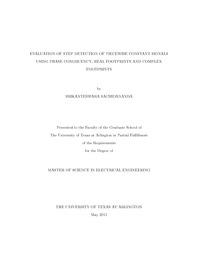| dc.description.abstract | Several applications involve the use of signals that are piecewise constant. Often, their measurements or observations are contaminated with noise. Detecting the steps and recovering the true signal from its noisy measurements is an important problem.There are a number of methods in the literature that address this issue. We use two different approaches. First, we use the idea of phase congruency in detecting singularities in a 1-dimensional piecewise constant signal. Phase congruency has been previously used in feature detection from images. It is a dimensionless quantity that gives an absolute measure in finding the edges or discontinuity in a signal. We calculate phase congruency measure using Interscale, Relative Phase and Derotated Phase wavelet coefficients, and observe their performance in detecting discontinuities.Second, we build on the work of Dragotti et al, where the concept of wavelet footprint transform is introduced. We extend this to a complex footprint transform. In image processing and analysis, coefficients from complex transforms are known to possess better properties than those using a real transform, since they possess both magnitude and phase information. These can be utilized in improving edge and feature detection. We study the properties of the complex footprint representation for 1-dimensional piecewise constant signals. We follow an algorithm developed by Regi-Pique et al, to detects steps in a piecewise constant signal using it's footprint coefficients. We studied the application of these methods to the field of bioinformatics. The first application involved step detection in order to find DNA copy number alterations. DNA copy numbers are piecewise constant, and discontinuities in the signal indicate possible genetic irregularities and are useful for cancer diagnosis. We attempt to extend the work of [3] by using complex wavelet footprints for detecting the discontinuities from its noisy measurements.The second application is with molecular motors data. These are biological motors that operate on a molecular scale, and studying their dynamics is useful in building synthetic motors that replicate their action. The dynamics of these motor are piecewise constant in nature. We use footprint based technique in recovering the signal from its noisy measurements. We observe that this approach outperforms existing signal recovery or noise removal methods. Thus, this report extends real footprint transform to a complex ootprint transform, and uses it in detecting steps in a piecewise constant signal. We also use Phase congruency for detecting discontinuities in such signals. Two applications where these can be implemented are then studied, and the results are analyzed. | en_US |

